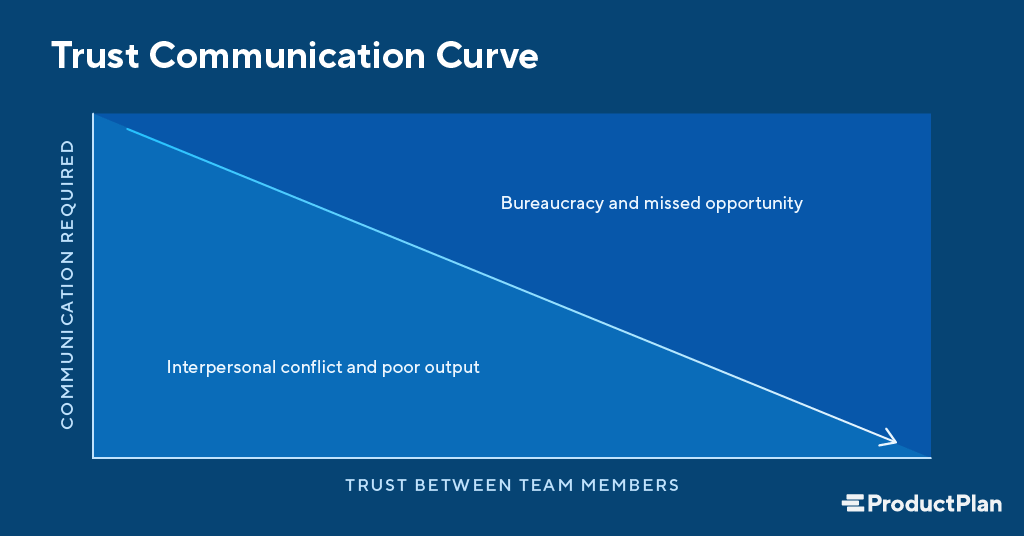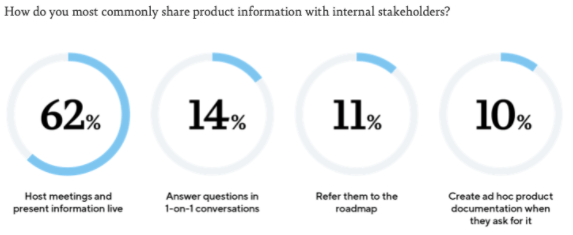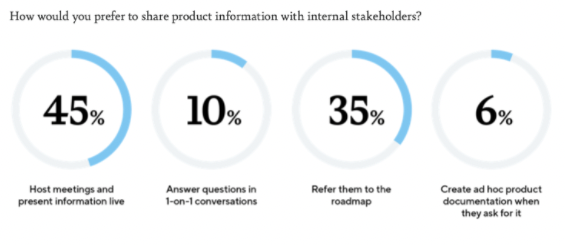There’s a concept in business called the trust communication curve. It states that the more trust between people or teams, the less one-on-one communication they’ll need to align on goals. If you graphed that curve, it would look like this.

The product trust communication curve follows the same logic. As trust increases, product managers can rely more on communicating information. They can even refer people to the roadmap, rather than repeating twice.
And according to the data we’ve collected, product managers want that ability. In ProductPlan’s 2022 State of Product Management Report, we uncovered interesting data points on this topic.
First, most product professionals (62%) share product information with internal stakeholders by hosting live meetings. That is more than 5x the number who said they refer people to the product roadmap and ask them to review it themselves (11%).

But when we asked how they would prefer to communicate this information, our survey respondents voted strongly in favor of asking stakeholders to review the product roadmap.
As you can see from the response percentages here, many product professionals (45%) would be happy to host a meeting with stakeholders. They don’t mind communicating product strategy, plans, or other details to everyone. But they don’t want to repeat answers to the same people asking the same questions repeatedly.

Why It’s Valuable to Understand the Product Trust Communication Curve
The sooner you establish trust across your company, you can reduce your time repeating yourself to stakeholders.
The more they trust the product team, the more your stakeholders will feel confident finding the answers to their questions. In other words, boosting trust with stakeholders is a great way to save your product team a lot of time.
In the next part of this post, I’ll offer suggestions for improving your product trust communication curve.
What Improves Trust Between Product Managers and Stakeholders?
Unfortunately, the first factor that increases trust is one you can’t manipulate: time.
I’ve worked with hundreds of product professionals in my career. I have also had the chance to work closely with customers. In my experience, I have found that more seasoned product people tend to trust their processes more. They and they also enjoy more trust from their colleagues. Both factors enable senior product professionals to communicate information once, and they can refer stakeholders to the roadmap instead of answering the same question twice.
Some of the trust you’ll earn as a product manager comes only with time and experience. But the good news is that there are things you can do today to improve your company’s product trust communication curve. Yes, even if you’re a newbie to product management.
4 Tips to Improve the Product Trust Communication Curve at Your Company
1. Invest in relationship building.
One key to building trust is to build familiarity. Your developers can’t trust you if they don’t know you. Time spent together—even just chatting in the lunchroom or exchanging fun GIFs over your chat app—can go a long way to establishing that level of comfort that leads to trust.
Also, the more time you spend talking with stakeholders across the company, the more you can develop a common language to ensure everyone aligns around product strategy, goals, and vision. Every department has a unique shorthand, and your role as a product manager includes uniting all stakeholders around a shared language.
2. Keep your roadmap accurate and up to date.
Trust goes both ways. Suppose you want to feel confident that your stakeholders will always be able to find the details of your latest strategy, timelines, and priorities. In that case, you’d better make sure that the roadmap is always current.
If your stakeholders trust you—but they don’t trust the roadmap will always be up to date—you can expect them to come to you with their questions every time.
And that’s one more reason to use native roadmap software. When your roadmap lives on multiple stakeholders’ computers as static files (XYroadmap-v3-new-FINAL-updated-v2.xlsx), someone could quickly be working from an outdated version. But if you have a purpose-built roadmap app, you’ll have one version—online, to which you can easily invite stakeholders—and updating it will be as simple as drag and drop.
3. Present your product information consistently
The details on your product roadmaps will change over time, and you’ll include different information from one roadmap to another. But to build trust, you’ll want to create as consistent a process as you can to present that information each time.
For example, if you add an epic or feature to the roadmap, you’ll want to explain how it supports the strategy. That process builds trust because it helps you show stakeholders the strategy behind your decisions. But here’s the key: Include that strategic reasoning every time you add an epic or feature.
Using purpose-built roadmap software, you can drop a strategic statement just below the epic in the same bar. What’s important is that your stakeholders learn to find that strategy in the same place each time they see a new initiative added to the roadmap.
To the degree your stakeholders have a consistent and predictable experience reviewing your product roadmap, it will enhance their trust in the process—and in you—and make them more self-sufficient.
And remember: the more your internal stakeholders become more self-sufficient at staying current on your product strategy, goals, and responsibilities, the less time you and your team will have to explain—and repeat those details.





